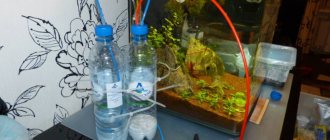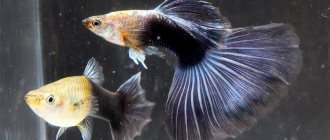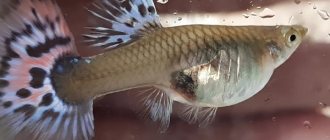Due to the unpretentiousness of pets, diseases of barbs can confuse the aquarist, since many beginners believe that these vigorous fish simply cannot get sick. However, their endurance is, of course, not absolute. More often, health problems in barbs arise from improper maintenance, when the fish are weakened or have metabolic disorders. All diseases are divided into contagious and non-contagious.
General information
Hornwort is an aquatic plant that even blooms underwater. It has long stems along which leaves of a very unusual shape are collected at equal distances in a ring. Repeatedly dissected with 5-8 apices, the leaf segments are very thin, long, slightly toothed, light green to dark green in color.
The root system is undeveloped, due to which the hornwort floats freely on the surface of the water. If necessary, it is fixed in the ground with the help of thin thread-like processes - rhizoids.
Hornwort is native to North America. However, it has a very wide habitat. In fact, it can be found on almost every continent except Antarctica. It grows at different depths in reservoirs with slow-flowing and standing water.
What can you do to siphon less often?
To siphon the soil in the aquarium as little as possible, you should reduce the number of fish and increase the number of plants with a strong root system. It is important not to overfeed the inhabitants so that less food remains are formed. Soil with particles of the same size does not cake, the likelihood of such a substrate becoming sour is minimal, so it makes sense to choose just such a soil. The more conditions in the aquarium are met, the less often the siphon is done.
However, even under ideal conditions, a siphon will be a must-have item in the management of an artificial reservoir. It is necessary to siphon each aquarium at a certain frequency (except for the cases described above). Based on the characteristics of the reservoir being cleaned, as well as personal preferences, you can choose a convenient and affordable type of siphon for yourself.
Next
Aquarium9 steps for making a compressor with your own hands
Common types
There are several dozen species of hornwort, but only 4 of them are used in aquarium farming.
| View | Description |
| Submerged or dark green hornwort | Long stems with dark green, hard leaves. It grows up to 60 cm in height, has leaves of 1-4 cm. It grows faster than others. |
| Semi-submerged or light green hornwort | It has a brittle, thin stem, soft, light green leaves, up to 6 cm long. It grows more slowly than other species. |
| Cuban hornwort | The most decorative of all. The leaves are located closer to each other, due to which it looks fluffier. The stem is not brittle, red in color. Unlike the others, the growing season of this species continues into winter. |
| Mexican Hornwort | Subspecies of light green hornwort. It has a brown stem. The most undemanding of all types |
Submerged Hornwort (Ceratophyllum demersum) or dark green
Pregnant platy
Breeding such fish is easy, since the creation of any special conditions is not necessary. Many people believe that the main sign of a pregnant platie is a large belly, but in fact this is not the case, since it can grow if the fish has eaten heavily. Changes in color or behavior are observed. And if such platies appear, their further reproduction can be carried out in a public aquarium, taking care of the shelter.
How to determine if a platie is pregnant?
If an aquarium owner wants to ensure regular breeding, then it is necessary to have three females and one male. Please note that this species is capable of producing offspring every month. When figuring out what a pregnant platie looks like, it is worth pointing out the rounded belly, but to confirm this symptom, it is recommended not to feed the fish for a day and observe whether the belly disappears or not. In addition, there is a more obvious sign that the individual is ready to reproduce - the color of the body changes near the anal fin.
Pregnancy of platie - term
It has already been mentioned that this species can produce offspring frequently. A pregnant platy bears the fry for about 28 days, and a couple of days after birth the female is ready for fertilization again. In the aquarium fish platies, spawning can occur up to several times per year. During birth, from 30 to 80 fry can be born.
Pecilia before childbirth
Before an individual is ready to give birth to fry, its abdomen will become large and take on an angular shape. Platies will have a more visible pregnancy spot, which is located near the anal fin. Every day it will become brighter. In addition, before breeding, the female will begin to behave restlessly and will have a desire to hide in a secluded place.
Maintenance and care
Hornwort is one of the most unassuming representatives of aquarium flora. It can be kept in both tropical and cool water aquariums. The plant will be comfortable with the following indicators:
- water temperature - 18-30 °C;
- hardness - 6-15;
- acidity - 7-7.5 pH.
The only important condition for hornwort is lighting. If it is deficient, the plant withers, the leaves fall off, and the edges of the stems rot. Provide it with moderate natural light, away from direct sunlight, for 12-14 hours. Or artificial, with lamps with a power of 0.3-0.5 W/liter of water.
Care requirements:
- Replace a quarter of the water weekly.
- The plant needs to be pruned. Hornwort grows very quickly (up to 2 cm per day), so it often needs this procedure.
- Since hornwort collects debris on its leaves, it needs to be washed. Do this carefully, with water at approximately the same temperature as in the aquarium.
Semi-submerged hornwort (Ceratophyllum submersum) or light green
Atypical behavior is a cause for concern
As practice shows, almost all diseases are accompanied by symptoms that can be used to recognize an infection. Initially, problems with the gastrointestinal tract appear, the appetite completely disappears, and the gourami stops moving. It is important to understand that one symptom can be characteristic of a dozen infections. It is for this reason that it is worth considering all possible options and not settling on just one.
The scales are peeling off
Shedding scales in gourami are a symptom of many diseases or a signal of injury.
If a fish's scales peel off, this may be a consequence of:
- damage to an individual from decorations or equipment with sharp edges. It is also worth considering that gourami can fight among themselves or with other inhabitants if the neighborhood is chosen incorrectly or the volume of the aquarium is critically small;
- the absence of scales can also be caused by a bacterial or fungal infection, resulting in a disruption in the functioning of internal organs;
- osmotic stress (sharp change or other discrepancy in the chemical composition of water) - this leads to the loss of scales and the appearance of deep wounds.
If there are wounds on the fish’s body, water penetrates into them and salts are washed out, which leads to pain and stress.
Red fins
If the fins turn red, this primarily indicates that the nitrogen balance in the aquarium is disturbed and the fish have been poisoned. For these purposes, it is worth immediately taking water samples and doing tests. In addition, it is worth considering that the fins may turn red if treatment is carried out and the dosage of the drugs used is not followed.
The appearance of mucus
Alkalosis
White mucus appears on the body, the gouramis become restless, the color loses its tint - it becomes transparent, the fish breathes frequently. The infected individual is transplanted into a container with clean water and the acidity level is gradually increased to an acceptable level.
Acidosis
Gourami begin to be afraid of almost everything and show great anxiety. You can see them swimming in circles, trying to find shelter for themselves. During treatment, the acidity level is gradually reduced.
Costiosis
Mucus appears on the body, the fish constantly rub against the ground, plants, and decorations. In this case, the appetite completely disappears, the fins stick together, and blue spots may appear. For treatment, you will need to prepare a bath with the addition of salt and/or malachite green.
The appearance of red spots
Red spots are not always a sign of illness . Very often these are color features that appear during spawning or during stressful situations. Also, red spots can be bruises caused by internal disorders or injuries. Special preparations are used to remove parasites. Small wounds heal on their own, but large ones will have to be treated personally.
Red spots can be located in different parts of the fish’s body and, depending on the presence of associated symptoms, can either indicate a disease or go away on their own. However, this is always a reason to pay extra attention to the fish!
Symptoms include:
- blue opacities form along the edges of the fins, forming a border;
- spots appeared as a result of blockage of blood vessels;
- fin rot;
- eyes become cloudy;
- White sores appear on the fins.
During treatment, the temperature of the water is raised to the maximum permissible level. Special preparations are added, and water is changed every 3 days - 40% of the total volume.
Stomach is swollen
During abdominal bloating, the fish becomes inactive and begins to refuse food. There may be several reasons, but all of them can be divided into safe and incompatible with life.
A female that does not spawn sometimes causes concern for the owner. In some cases, for good reason...
If we consider the most common reasons, we can highlight the following points:
- Perhaps the most common and at the same time pleasant reason is that the female’s belly is filled with caviar, so it appears swollen. Some females become so swollen before spawning that they may appear to have a tumor.
- The second reason is the appearance of tapeworms. You can bring them along with food. As a rule, they do not cause harm. However, if you create favorable conditions for them, the reproduction process will not take long to occur. Due to the large number of tapeworms, the gourami begins to weaken and lack nutrients, which can lead to death. Anthelmintic drugs are used for treatment.
- Gourami bloat due to an unbalanced diet, strong and frequent overfeeding, and this can also be caused by obesity.
If the bloating is caused by a tumor of the internal organs, then it will not be possible to save the sick individual.
Beneficial features
Hornwort is practically indispensable when starting a new aquarium, because it is very important to establish a biological balance in it as soon as possible. Living plants play an important role in the process of forming and maintaining proper chemical balance. But while other plants need quite a long time to adapt and start growing, hornwort begins to grow and “work” almost instantly. This helps avoid unwanted outbreaks of ammonia nitrites and nitrates in a new aquarium. And significantly reduce the time to establish balance.
The beautiful and unpretentious hornwort also has a number of useful properties for the aquarium:
- Helps cleanse the aquarium of algae;
- purifies water from suspended substances and feed residues;
- fry and small fish take refuge in the fluffy leaves of hornwort.
How to plant hornwort
It will not be possible to plant hornwort in the ground like an ordinary plant, since it does not have roots. It is also undesirable to bury the plant stem in the ground and simply press it down with stones. Over time it will begin to rot. It is best to use suction cups and fishing line. The fishing line is tied to the stem on one side, and to a suction cup or weight on the other. Do this carefully so as not to damage the plant.
It is better to plant it in the corners of the aquarium or at the back wall. You can also leave the hornwort free-floating.
Why isn't it growing?
Even such an unpretentious plant as hornwort can grow poorly, turn yellow and shed its leaves. The main reasons are:
- poor-quality soil and decor for the aquarium, which emit harmful substances that affect the plant;
- hornwort does not tolerate medications used to treat fish;
- bad light;
- insufficient filtration and rare water changes;
- sudden changes in water parameters.
At home, as well as in natural conditions, hornwort has a growing season. So, in autumn and winter, the growth of the plant slows down: it sinks to the bottom and often loses all its leaves, leaving only the upper shoots.
In spring it will quickly restore its previous size and beauty. Do not confuse the vegetative sleep of a plant with diseases.
Pregnancy period
A pregnant female guppy is very easy to distinguish from the general mass of fish by her appearance.
At the first stage, her belly is rounded and enlarged, in which eggs are formed and developed.
Over time, it becomes rectangular with a clearly defined black area at the bottom.
During this period, the head and abdomen are separated by a sharp drop, which is often called a “step.”
In the last days of pregnancy, the fish's anus swells, which is the main sign of impending labor (in one to two days).
The gestation period of a guppy lasts from thirty to forty-five days. The timing is influenced by the conditions of detention (water temperature, feeding, etc.) and the genetic characteristics of individual varieties.
The higher the water temperature in the aquarium, the shorter the guppy's gestation period will be.
The number of fry is affected by the age and size of the females :
- At the first birth from 10 to 30;
- During the second birth from 20 to 50;
- In the third and further from 20 to 100.
It is known that one female gave birth to more than one hundred and eighty fry. Although it is very difficult to accurately calculate how many fry a guppy gives birth to, since they can be eaten by the female immediately after childbirth or during it.
Female guppies breed at intervals of three to six weeks.
Fertilizers
For nutrition, hornwort has enough substances supplied with water during water changes and fish food. It does not require additional fertilizers or carbon dioxide supply.
Hornwort is a versatile plant that combines well with other plants and is suitable for all types of fish. Its advantages, low maintenance requirements, very rapid growth and reproduction have made it one of the most popular among beginners and experienced aquarists. By planting hornwort in an aquarium, you will receive not only decoration, but also a natural filter.
What types of aquarium siphons are there?
Siphons for cleaning aquariums differ from each other in size, funnel shape, and method of water suction.
The siphon should be selected based on the size of the aquarium. There are models for high capacities, standard and very small.
The cross-sectional shape of the funnels is round and with one right angle for cleaning at the corners of the container, and the rest is round. To clean the space between snags and stones, narrow siphons are used.
There are models in which the flow of water is created using a pear, as well as a sharp lowering and raising of the cylinder. Siphons with a pear are more convenient to use, but are short-lived.
There are electric siphons that run on batteries. They can suck water from a container and immediately drain it into the sewer. Or they can clean it and return it back to the aquarium. Such models are good for containers where the soil is heavily contaminated, and too large changes cannot be made.











